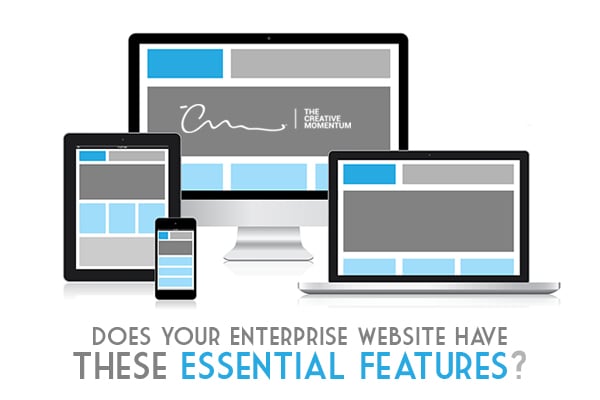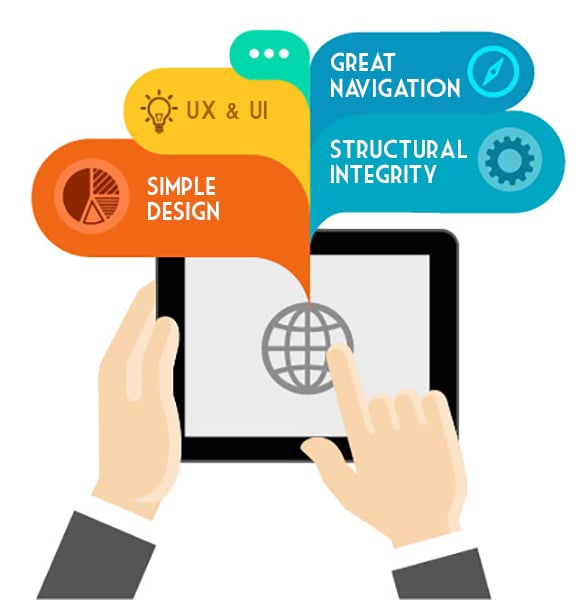 Enterprise businesses face unique challenges that small businesses might not experience to the same extent. In the business world, enterprise is a term that’s usually reserved for large businesses – firms with multiple locations, a large workforce, or higher annual revenue. These types of companies often need to create flexible websites that can support large teams, significant activity, and, function smoothly. Here's our quick list of enterprise website essentials.
Enterprise businesses face unique challenges that small businesses might not experience to the same extent. In the business world, enterprise is a term that’s usually reserved for large businesses – firms with multiple locations, a large workforce, or higher annual revenue. These types of companies often need to create flexible websites that can support large teams, significant activity, and, function smoothly. Here's our quick list of enterprise website essentials.
1. A Flexible Website That Scales
If you're an enterprise business, you’re working with volume. You can expect significant web traffic from employees and end users who access and interact with your website.
Your website's performance shouldn’t suffer because of high traffic volume. No one wants a website that frequently crashes or stalls. The solution? Develop a website that's scalable:
- Strong data support for fast recovery
- 24-7 availability
- Functional website support
Build these redundancies or efficiencies into your website from day one rather than wait for problems to arise and fixing them later. Look for ways to relay processes faster to reduce lag time. Similarly, ensure your servers can support larger capacities—so many users can be served simultaneously.
2. A Compatible Content Management System
Once upon a time, if you wanted unique functionality on your website, you had to have it built from scratch. These days, there are robust CMS systems out there that will fit the needs of many enterprise websites. The biggest – WordPress – has come a long way from its origins as a blogging platform. There are billion dollar clients using the Wordpress platform for personalization, integrations, and more.
These robust content management systems allow you to have a fairly custom design while also giving your marketing team intuitive tools they need to make simple edits and changes to the site without needing the help of a developer.
The biggest benefit of this is intuitive; no one wants a website that only the web developer can touch. The increased proliferations of plug-ins have also made it easy to add functionality to your site without needing to understand programming code.
The reduced cost and increased agility associated with using an out-of-the-box solution as opposed to building it from scratch can’t be ignored, indeed it's the standard.
3. Good UX and UI Design

If your corporate website is clunky, difficult to navigate, or visually confusing, you’re missing the mark. User experience (UX) and user interface (UI) are two key essential components of building a business website that’s both functional and enjoyable for visitors to use.
This is incredibly important if your enterprise business revolves around a digital solution that requires your customers to access your website frequently. Especially with business customers, keep your designs simple. Don’t force them to wander aimlessly from page to page or link to link to look for what they need.
Intuitive Navigation
Your navigation should be intuitive; employees and customers shouldn't be confused when they travel between pages. Focus on topline categories and consider user intent to prioritize the important topics your customers most likely need. Also, include a sitemap as it provides directional cues for your customers (and search engines) as they browse the site.
4. Tight Data Protection
To be clear, data protection should matter for every business owner with a website. But enteprises that collect sensitive and private information or financial details need to go the extra mile when it comes to securing their websites.
Go beyond ensuring that you're using “HTTPS” protocol in the web address bar. Invest in security protocols that eliminate code vulnerabilities where malware could be introduced. Add-ons such as APIs and plugins can serve as a source for security breaches. Most importantly, keep your software up to date and avoid using plugins that haven’t been updated recently or come from dubious sources.
5. Design That Supports Customer Acquisition
Along with being structurally sound and safe, your website needs to provide a benefit to end users. Your website should make it easy for your buyers to identify:
- your purpose
- how you stand out from the competition
- the value you provide
- the easiest way to move forward in the buyer's journey
This means you need to meet your customers where they are. With the continued dominance of mobile search, this means that you should rely on responsive design rather than stand-alone mobile assets.
Some functions may be modified, such as gestures to interact with a page or larger buttons to accommodate fingers instead of mouse cursors, but customers shouldn't experience a jarring disconnect between mobile and desktop browsing.
6. ADA-Compliant and Accessible

Roughly a quarter of all American adults have some form of disability. This ranges from “invisible” disabilities such as being color blind to anxiety to physical impairments.
This means that you can assume everyone coming to your website has different abilities.
Create an accessible website. This means incorporating the guidelines outlined by the World Wide Web Consortium (W3C). While the guidelines are lengthy, they provide clear instructions on how to develop a website that reduces barriers that might alienate a segment of your audience. Basic concepts include:
- Avoid the use of color as a cue for user actions
- Adopt website functionality that works with screen readers
- Allow for adaptable font size
- Provide descriptive links
- Add alt-text descriptions to all images
While prioritizing accessibility is one of these enterprise website essentials that is itself the right thing to do, improving accessibility also boosts your SEO.
Enterprise Website Essentials That'll Meet Everyone’s Needs
Enterprise websites can be tricky to design because you're trying to appease customer expectations, and (sometimes) significant workforce needs. The sheer volume of users and data flowing through the website requires a commitment to security and structural integrity to ensure durability. No matter which way you dice it, creating websites for larger businesses is a larger effort.
Luckily, we can help with that. The Creative Momentum builds websites with scalability integrated into the design and those that prioritize a UI and UX strategy that makes it intuitive and user-friendly.


